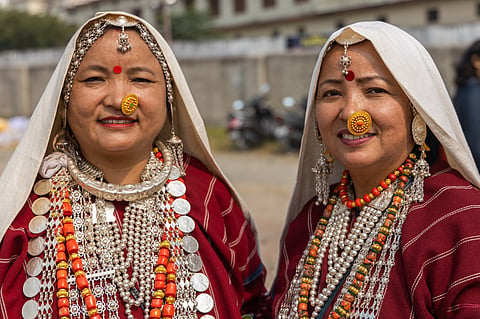- Destinations
- Experiences
- Stay
- What's new
- Celebrating People
- Responsible Tourism
- CampaignsCampaigns
- SubscribeSubscribe
- Buy Now

Jewellery has always been an integral part of Indian culture. From signifying traditional relevance to accentuating one's appearance, ornaments are more than beads and metal. Each has its history. For example, jhumkas, a go-to earring for festive and wedding seasons, is believed to have originated during the Chola dynasty, around 300 BCE. The diverse Indian landscape has metamorphosed these accessories into more than just objects. Today, they serve as the identity of individuals and states alike.
As someone who hails from Uttarakhand, my love for jewellery is synonymous with nath and galobandh, trinkets that distinguish a Pahadi bride from a non-Pahadi. These beautifully carved jewels are rooted in a regional blend representing the cultural practices of Garhwalis, Bhotiyas, Kumaonis, Jaunsaris—the many communities of Uttarakhand. Take a look at some of these traditional accessories from the Himalayan state, playing up its ethnic identity for generations:
These are square-shaped gold studs embedded in red fabric, distinguishing the pahadi 'choker' from what you wear in towns. What sets this aesthetically crafted neckpiece apart is its symbolic importance. These pieces often carry religious and social connotations and are only worn by married women during weddings, festivals, and religious ceremonies.
This exquisite nose accessory is essential to brides and married women's trousseau. Presented as a token of love from the maternal uncle's side, these round-shaped nose rings have motifs inspired by nature. What distinguishes the Pahadi Nath is its unique design. It is characterised by a large circular or semicircular ring on the left nostril, connected by a gold chain or string that hooks onto the ear or hair.
Pahunchi is a bracelet/bangle designed using gold or silver beads on a red cloth belt. Worn by married women and brides, Pahunchi is often passed down through generations as heirlooms, symbolising familial ties, status, and tradition. Women commonly wear it during weddings, festivals, and other auspicious occasions.
Also called "Kaan Bali" or "Kaan tikka," Kaanphool's design varies across different regions of Uttarakhand, showcasing diverse artistic influences and local traditions. The Jaunsari women mostly wear these flower-shaped earrings.
Hansuli necklaces are typically made of silver, incorporating symbols of nature, such as leaves, flowers, and birds, reflecting the region's close connection to its surroundings. You will find Garhwali, Kumaoni, Bhotiya and Jaunsari women donning this beautiful ornament. In many villages, there is a practice of women lending their Hansuli to those who cannot afford it.
The Pauje of Uttarakhand, akin to the traditional Indian anklets called payal, is mounted with ghunghroos (metallic bells), and motifs, embodying Pahari culture's essence. Although design nuances may arise across regions such as Kumaun, Garhwal, and Jaunsar, Pauje remains a unifying thread binding these areas together.
(Info source: Pauri Garhwal Uttarakhand/Facebook)
